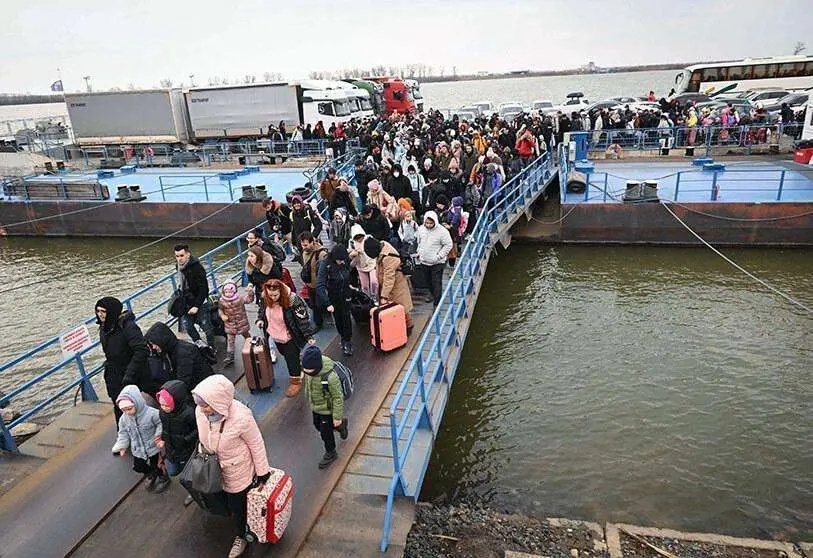Migrations: eastern flank and southern flank

It has been said that journalism is, in a way, history, a synchronic history, which tells (and gives an account of) events that coincide in time, at a precise moment in time, and therefore a necessarily provisional and partial history.
The reading of what has been published in a delimited period of time thus offers us a photograph, a static image capable of stopping the flow of events, ideally separating them from their causes and effects. Based on these ideas, the following lines aim to refer to what was published on migration issues in the first half of the year, to contemplate a recent photograph of migration based on the events that were the subject of news and commentary in the Spanish media during those months.
The image offers us, on the one hand, clear faces coming from Eastern Europe. These are the Ukrainian refugees fleeing their country due to the Russian invasion. According to UNHCR data, since the beginning of the Russian military offensive on 24 February, more than 14 million people have had to leave their homes, either to seek refuge in neighbouring countries (refugees) or to move to safer areas of Ukraine (internally displaced persons). In addition to some 7 million IDPs (and as many refugees), UNHCR estimates that another 15 million people may be in need of protection and assistance inside the country: these are citizens who have been trapped in areas close to the front lines of the fighting, which are difficult for humanitarian aid to reach.
The reception given in Spain (and in the different European countries) to the Ukrainian refugees, generally supportive and generous, contrasts with, for example, the treatment received on the same dates (early March) by the more than 850 people from the south of the Sahara who entered our territory by jumping the fence separating Melilla from the Moroccan province of Nador. Although some political parties have unfortunately used the adjective 'genuine' to refer only to Ukrainian refugees, most of these sub-Saharan Africans from Mali and Sudan were also 'genuine' refugees fleeing armed conflicts and situations of extreme violence, only in their case they had to cross borders illegally in order to seek asylum.
That same Melilla fence was the scene, on 24 June, of an extremely tragic situation: an attempted irregular entry of some 1,500 people, resulting in the death of at least 23 migrants (a figure that NGOs put at more than 30). President Sánchez's first words in reference to this event (defending the actions of the Moroccan Gendarmerie and blaming the tragedy on the mafias that traffic in human beings), although they were later qualified in successive statements, triggered a harsh confrontation between the PSOE and its main parliamentary allies. For his part, the president of the European Council, Charles Michel, avoided making a critical statement on the events, expressing his solidarity with Sánchez's government and his condolences to the families of the victims.
The serious events in Melilla on 24 June should be seen in the context of the normalisation of relations between Spain and Morocco last April (following the prime minister's change of position on Western Sahara). They also preceded the NATO summit in Madrid (which took place on 29-30 June) by days.
Alongside these events on the eastern and southern flanks, which are a good example of the contradictions of the European Union's migration policies, and which deserved the most media attention, the 'migration picture' of the period described is completed with the account of other events closely connected to them: the aforementioned change in the Spanish government's position on Western Sahara generated a diplomatic confrontation with Algeria, whose cooperation on immigration is almost as important for Spain as that of Rabat. This distancing, among other consequences, could have repercussions on the increase in the migratory route by sea from Algeria to the Balearic Islands and the coast of the Levante peninsular.
The aforementioned NATO summit placed the use of irregular immigration as a weapon of pressure among the "hybrid threats", alongside energy blackmail and cyber-attacks. In the same area, when addressing the security of the southern flank, irregular immigration has (again, inevitably?) been associated with terrorism.
In short, the period analysed, framed temporally between the Russian invasion and the NATO summit, shows a reconceptualisation of migratory flows, which to some extent are "infected" (also linguistically) by the war context that Europe is experiencing. The most significant migration-related events of the first half of the year have highlighted the inconsistencies of European migration policies, while also pointing to the threat that the manipulation of migration flows can pose to European borders (not only for the southern flank, the most geographically relevant for Spain, but also for the eastern flank: remember, for example, Belarus's use of migrants from the Middle East on its border with Poland).
Luis Guerra, PhD in Philology, is an associate researcher of the INMIGRA3-CM project, financed by the Community of Madrid and the European Social Fund.

